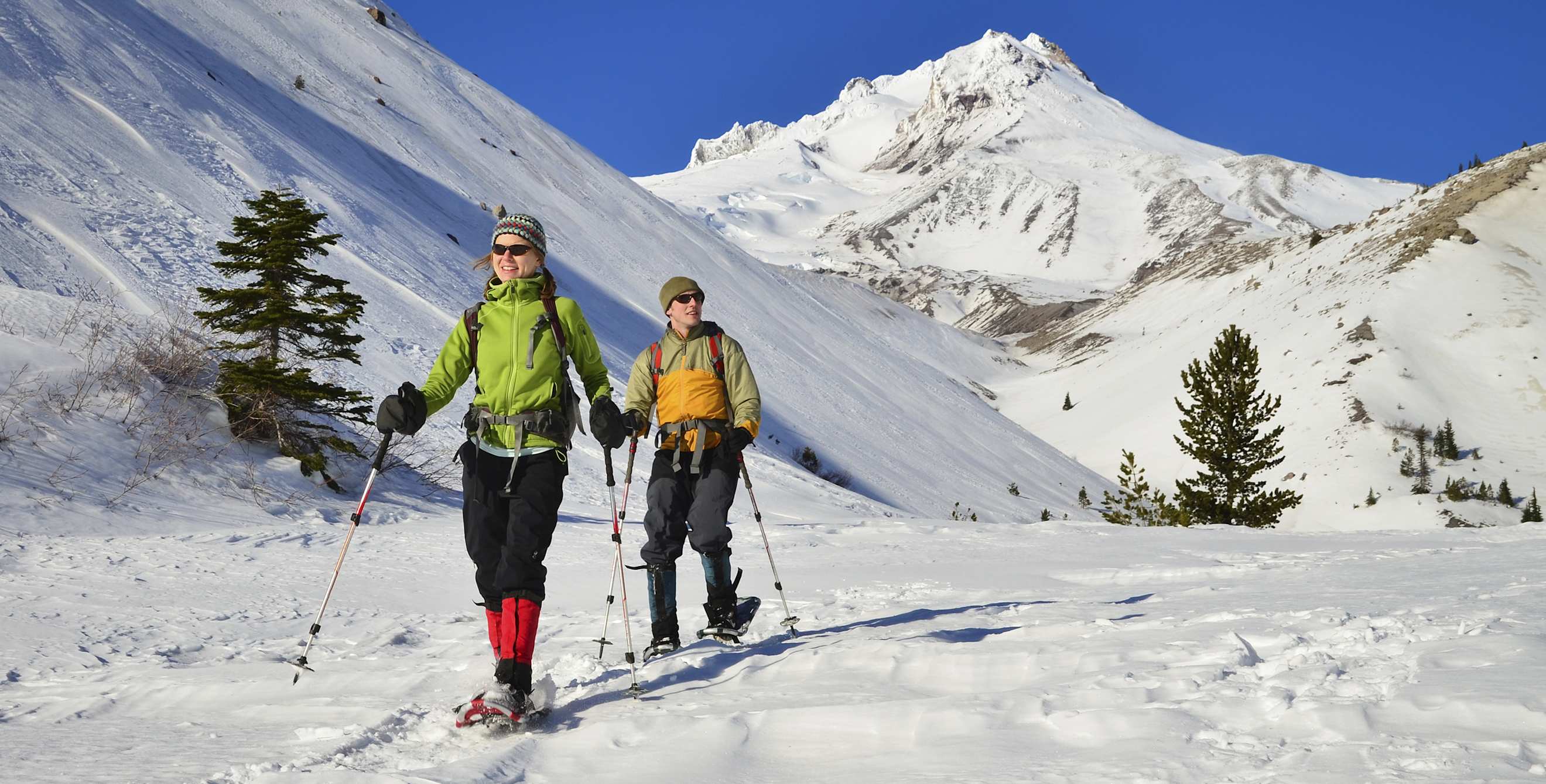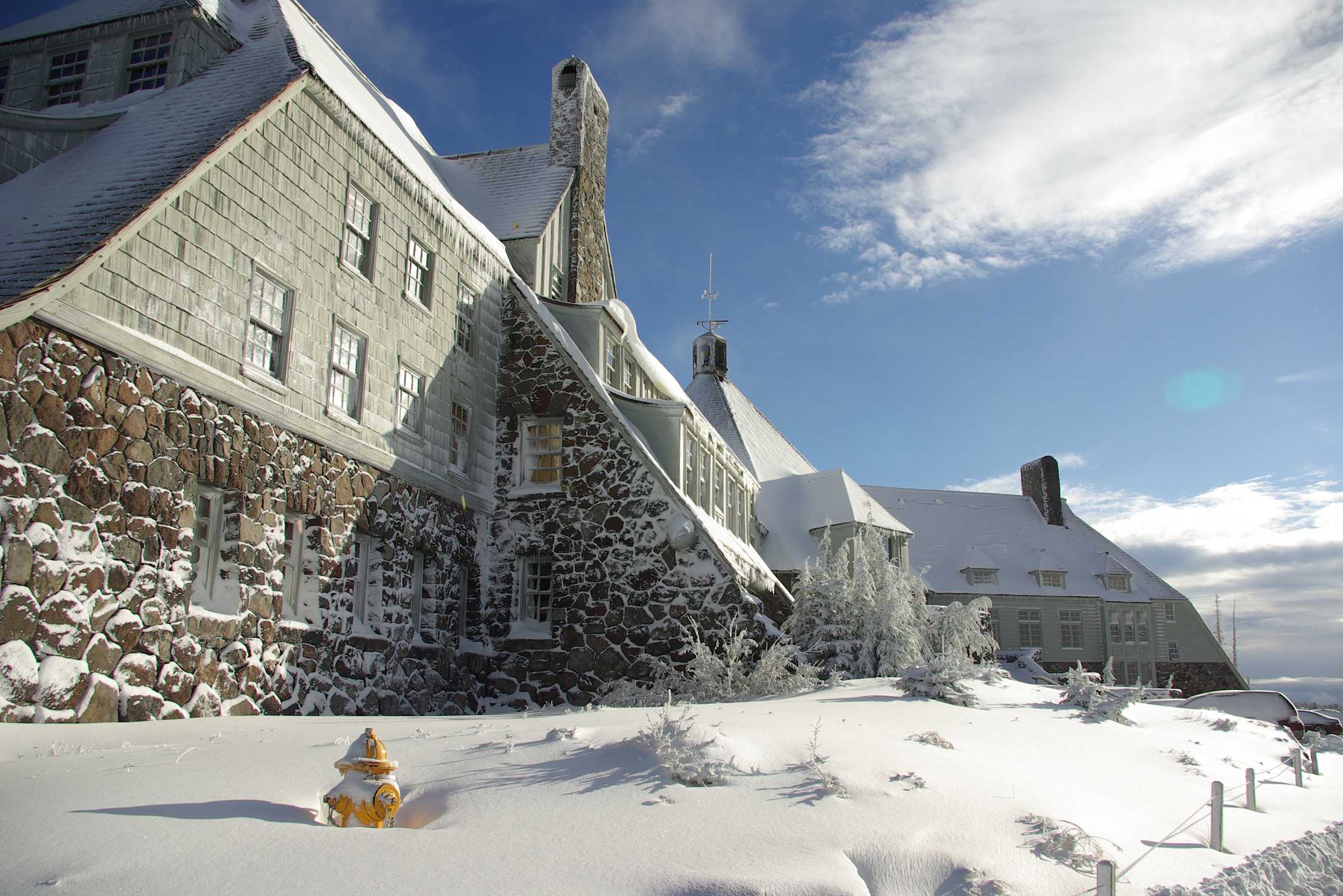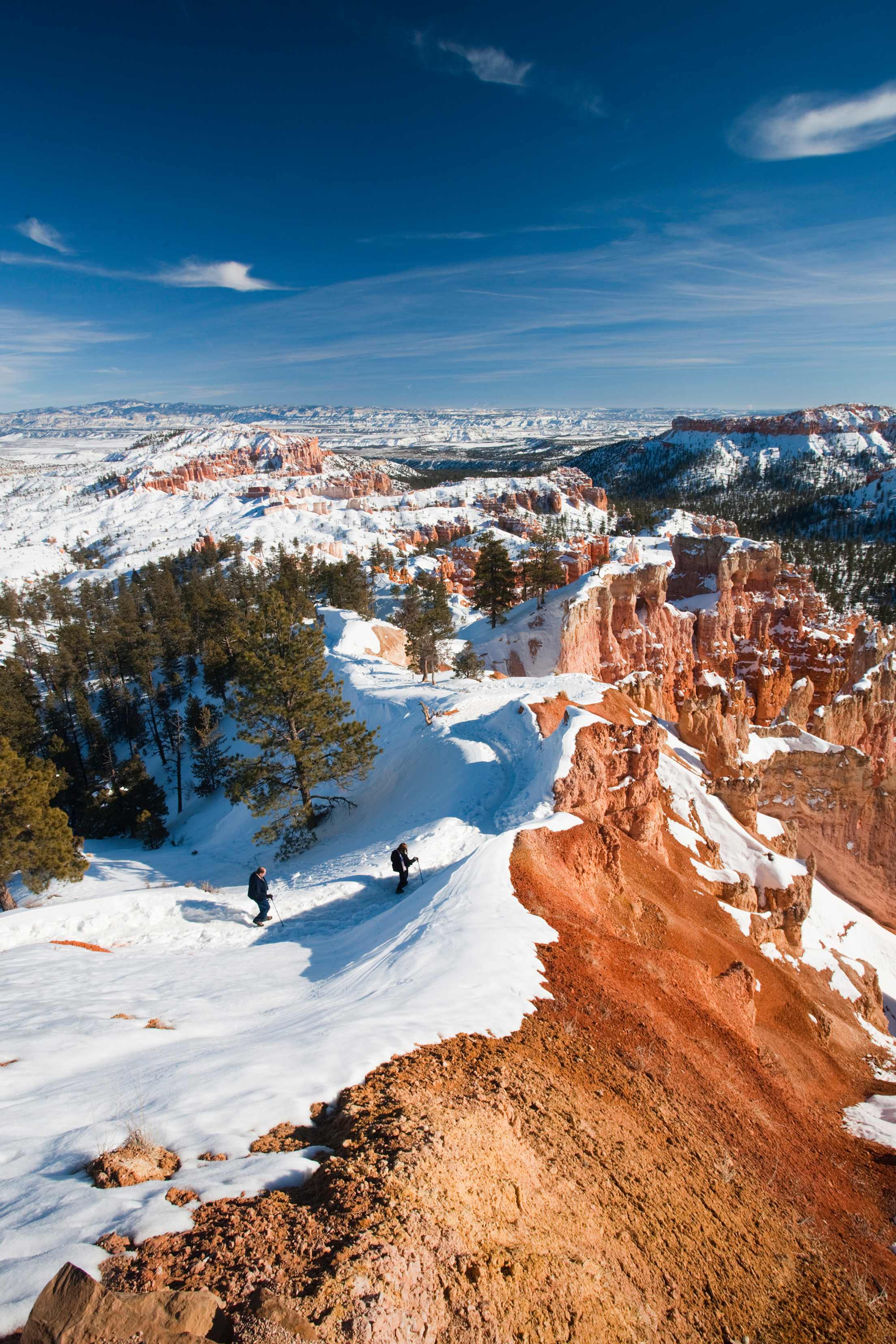
3 Top Nature Spots for Winter Fun
Yellowstone, Mt. Hood, and Bryce Canyon offer dramatic snowy landscapes and outdoor excursions.

Winter Fun in Yellowstone National Park
Snow piles on the backs of sleeping elk, geyser steam billows against a cold sky, a wolf pack slinks single file across a stark white hillside. Winter in Wyoming’s Yellowstone National Park sits in stark contrast to the overheated bustle of summer.
“The payoff can be tremendous, if you can bear the cold,” says Shauna Baron, a tour leader with the Yellowstone Association, a group that offers winter excursions in the park.
And there are certainly ways to bear the cold. The plowed road between the northeast entrance and Mammoth Hot Springs provides 50 miles of sightseeing by car. Elk and bison search deep drifts for grass, while wolves have other things in mind. “It’s the breeding season, so they’re always talking to each other,” Baron says. “When the wolves howl, it sounds like it’s echoing across the entire world.”
For more active adventurers, trailheads along the road lead into backcountry meadows and forests of Douglas fir and spruce in the park’s northern range. Whether you’re on snowshoes or cross-country skis, the powdery snow squeaks like Styrofoam beneath you, the air snaps at your cheeks, and you feel a close connection to the animals around you.
Those who prefer a bit more comfort can glide down the road in a heated snowcoach, a classic way to see the park this time of year. The machines—part bus, part snowmobile—carry guests from West Yellowstone, Montana, to Mammoth Hot Springs, Old Faithful, and other spots. Coaches move slowly, letting you see details you’d fly past in a car. Bison often share the road, and you can see their mahogany eyes and snow-caked beards as you pass through a herd. The hot springs and geysers along the Firehole River provide a steamy contrast to the frozen landscape. Snow transforms Old Faithful, too, which often plays before a nearly empty boardwalk. Without the chatter of summer crowds, you can hear individual drops of spray hit the ground.
With a change of seasons, some of the most famous natural scenes on earth become very personal. Yellowstone belongs to the world, but it’s yours when the cold comes. And after you’ve seen your fill you can repair to the Old Faithful Snow Lodge and sip an espresso before the fireplace, a warm end to a wintry day.

Winter Fun in Mount Hood
With 12 permanent glaciers, Oregon’s Mount Hood never really runs out of snow. The 11,240-foot dormant volcano east of Portland rises above the green Pacific Northwest like an island of winter. In a good year, the middle of the mountain can be buried in as much as 400 to 500 total inches of snow.
The mountain boasts three ski resorts, including Timberline Lodge, a wood, stone, and wrought-iron tribute to high-altitude comfort. If you can tear yourself away from the lobby’s warmth and mountain views, you can, of course, spend the day skiing many mellow, family-friendly runs. And there are plenty of things to do besides skiing. The lower end of Mt. Hood Skibowl resort provides the perfect pitch for inner tubing, a favorite activity for kids as well as adults with a still-working memory of childhood. On Friday, Saturday, and Sunday nights, the tube trails go “cosmic” with flashing lights and high-energy music.
Beyond the resorts, Mount Hood’s epicenter is Government Camp, a low-key mountain town with restaurants such as Glacier Haus Bistro, where hearty European fare—think rich beef goulash and half-liter pours of German beer—matches the rustic interior.
You can also rent snowshoes, cross-country skis, and snowmobiles or join a guided tour to explore hundreds of miles of groomed trails in the area.

Winter Fun in Bryce Canyon National Park
The towering red, orange, and apricot hoodoos of Utah’s Bryce Canyon never look more glorious than after a fresh dusting of white. At 8,000 to 9,100 feet above sea level, Bryce tends to catch snowfall throughout the season.
“The snow adds one more accent to all of the colors,” says Jean Seiler of Ruby’s Inn, a recreation hub near the park entrance in Bryce Canyon City. Every Presidents’ Day weekend, weather permitting, Ruby’s hosts a winter festival that celebrates the season with cross-country skiing, snowshoe tours, and crafting classes.
The park road skirting the edge of the canyon stays plowed throughout the winter, and so do the drive-up overlooks, making it easy to take in the surreal scene of white snow frosting the desert rockscape. Most of the hiking trails down to the bottom of the canyon are open during this time, too; just know that the icy spots can be tricky if you’re not wearing metal cleats. (The visitor center sells sets that strap onto hiking boots.)
Skiing down into the canyon is not allowed, but gently undulating cross-country trails wander the plateau both inside and outside the park. Some can take you to the rim, letting you glide above the snowcapped hoodoos. You don’t even have to bring your own gear. Ruby’s rents all manner of sports equipment, including ice skates for the outdoor rink. And the park lends snowshoes for free to visitors who join guided walks, which run all season when there’s enough snow.
The favorite activity at Bryce will always be just taking in the vistas from the park’s many viewpoints. “In the winter light, with the sun low on the horizon, we get some spectacular color and contrast,” Seiler says. Professional photographers come here for big-money shots, but anyone with a decent smartphone can get a bragworthy picture. Show up on a clear winter night, and depending on the phase of the moon, you’ll behold either the shiniest stars and darkest skies you’ve probably ever seen in your life or an otherworldly glow from the snow-covered rocks.
What you won’t see during a Bryce Canyon winter is crowds of people. It’s the quiet season in every sense. Even the animals, for the most part, tend to move down to lower altitudes. So take it all in while you can. Winter lasts for only a few months, and you’re lucky enough to be in the middle of it.
Let AAA Travel Agents plan your winter getaway and find discounted lift tickets, car rental, hotels, and more. It's a free benefit for AAA Members.